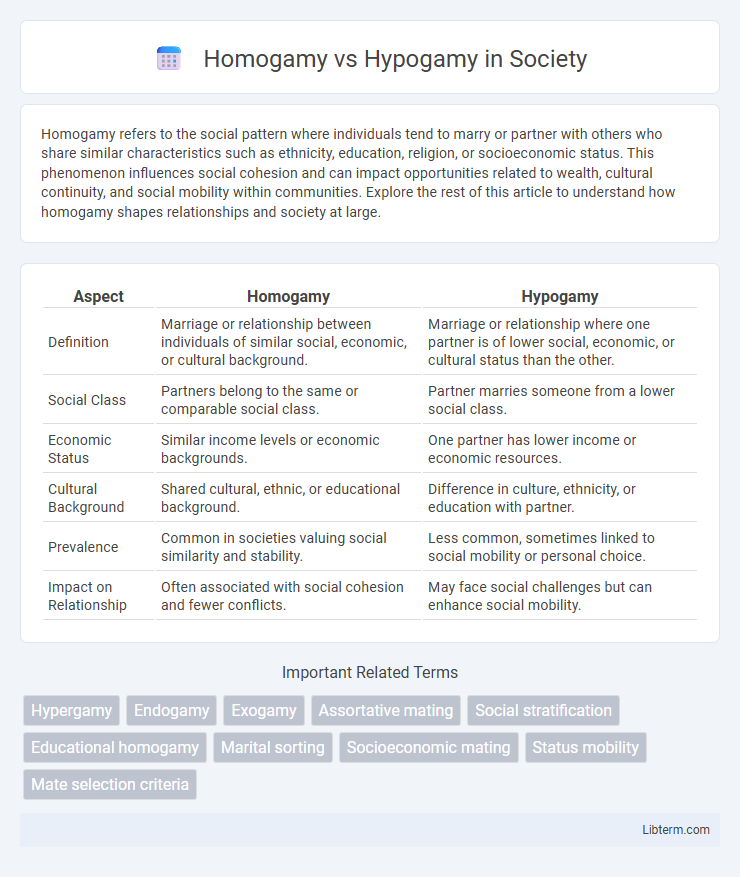Homogamy refers to the social pattern where individuals tend to marry or partner with others who share similar characteristics such as ethnicity, education, religion, or socioeconomic status. This phenomenon influences social cohesion and can impact opportunities related to wealth, cultural continuity, and social mobility within communities. Explore the rest of this article to understand how homogamy shapes relationships and society at large.
Table of Comparison
| Aspect | Homogamy | Hypogamy |
|---|---|---|
| Definition | Marriage or relationship between individuals of similar social, economic, or cultural background. | Marriage or relationship where one partner is of lower social, economic, or cultural status than the other. |
| Social Class | Partners belong to the same or comparable social class. | Partner marries someone from a lower social class. |
| Economic Status | Similar income levels or economic backgrounds. | One partner has lower income or economic resources. |
| Cultural Background | Shared cultural, ethnic, or educational background. | Difference in culture, ethnicity, or education with partner. |
| Prevalence | Common in societies valuing social similarity and stability. | Less common, sometimes linked to social mobility or personal choice. |
| Impact on Relationship | Often associated with social cohesion and fewer conflicts. | May face social challenges but can enhance social mobility. |
Understanding Homogamy and Hypogamy
Homogamy refers to the practice of marrying or forming relationships with individuals who have similar social, cultural, or economic backgrounds, promoting shared values and stability. Hypogamy involves marrying or pairing with someone of a lower social or economic status, often influenced by cultural norms and economic factors. Understanding homogamy and hypogamy helps explain patterns in partner selection, social mobility, and the reinforcement of social stratification.
Historical Perspectives on Marriage Patterns
Historical perspectives on marriage patterns reveal homogamy as a long-standing practice where individuals marry within similar social, economic, and cultural groups, promoting social cohesion and stability. Hypogamy, the practice of marrying into a lower social or economic status, has been less common but observed in certain historical contexts, often influenced by shifts in social mobility and gender dynamics. Studies in historical sociology and anthropology highlight how these patterns reflect broader societal structures and changing norms over time.
Social and Cultural Influences on Partner Choice
Homogamy involves choosing partners with similar social, cultural, and economic backgrounds, reinforcing social cohesion and shared values within communities. Hypogamy occurs when individuals select partners from lower social or economic strata, often influenced by cultural acceptance or shifting societal norms. Both partner choice patterns reflect underlying social structures, cultural traditions, and the dynamics of status preservation or mobility.
Economic Factors Shaping Homogamy and Hypogamy
Economic factors significantly influence patterns of homogamy and hypogamy, with individuals often selecting partners based on comparable or lower socioeconomic status. Homogamy tends to occur among those sharing similar income levels, educational backgrounds, and occupational prestige, reinforcing social stability and economic parity within couples. Hypogamy, in contrast, involves individuals marrying partners with lower economic status, which can be driven by factors such as wealth redistribution, social mobility strategies, or cultural norms valuing other attributes beyond financial equivalence.
Educational Attainment and Marriage Trends
Homogamy in marriage often correlates with partners sharing similar educational attainment levels, promoting social cohesion and mutual understanding. Hypogamy, where one spouse has lower educational qualifications than the other, reveals shifting marriage trends influenced by evolving gender roles and economic factors. Studies show that educational homogamy remains prevalent but is gradually challenged by increased acceptance of diverse educational backgrounds within partnerships.
Gender Roles in Homogamy and Hypogamy
Homogamy typically reinforces traditional gender roles by pairing individuals with similar social, cultural, and economic backgrounds, often maintaining established expectations for men and women within the relationship. Hypogamy, where one partner marries "down" in social or economic status, may challenge conventional gender roles, especially when women marry men of lower socioeconomic standing, potentially shifting power dynamics and role expectations. These mating patterns influence how gender norms evolve within families and impact broader societal views on gender roles and hierarchy.
Impacts on Family Dynamics and Children
Homogamy, the marriage between partners of similar socioeconomic status, often contributes to greater family stability and consistent parenting styles, which positively influence children's emotional and academic outcomes. Hypogamy, where individuals marry partners of lower socioeconomic status, can introduce economic stress and differing cultural expectations, potentially leading to conflicts in family roles and mixed impacts on child development. Research indicates homogamous families typically experience lower divorce rates and enhanced social capital, providing children with more cohesive support systems compared to hypogamous families.
Homogamy and Hypogamy in Different Cultures
Homogamy, the practice of marrying within one's social, ethnic, or cultural group, is prevalent in many societies as it reinforces shared values, traditions, and social cohesion. Hypogamy, characterized by marrying someone from a lower social or economic status, varies significantly across cultures and is often influenced by local customs, economic factors, and gender norms. In patriarchal societies, hypogamy may be less common due to social stigma, whereas in more egalitarian cultures, it can be a strategy for social mobility or personal choice.
Changing Trends in Modern Relationships
Homogamy, the practice of marrying within similar social, cultural, or economic backgrounds, is increasingly contrasted by rising trends in hypogamy, where individuals marry partners from lower socioeconomic statuses. Modern relationships reflect these shifts as globalization, education access, and evolving gender roles facilitate broader mobility across traditional social boundaries. Data from recent sociological studies indicate a growing acceptance of hypogamous unions, especially among younger generations valuing emotional compatibility over conventional status alignment.
Future Directions and Societal Implications
Future directions in homogamy versus hypogamy research emphasize the evolving impact of digital dating platforms and shifting socio-economic structures on partner selection patterns. Societal implications include potential changes in social mobility, with homogamous unions reinforcing existing inequalities while hypogamous matches may challenge traditional class boundaries. Understanding these dynamics is crucial for policymakers addressing family stability, economic disparity, and social cohesion in increasingly diverse populations.
Homogamy Infographic

 libterm.com
libterm.com